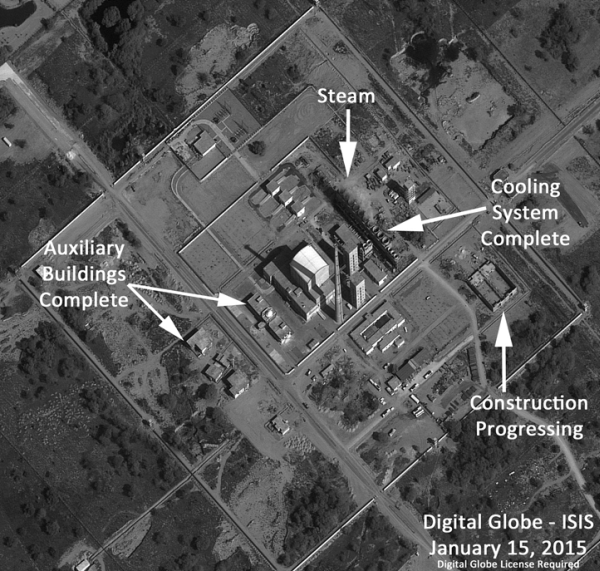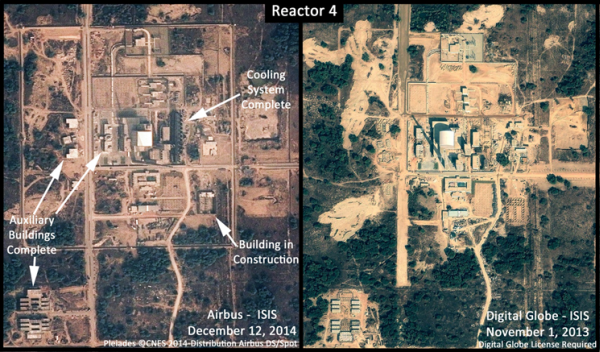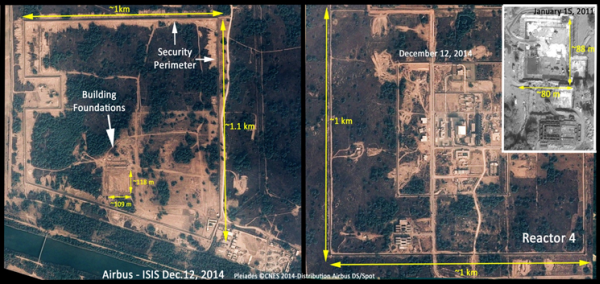Reports
Pakistan’s Fourth Reactor at Khushab Now Appears Operational
by David Albright and Serena Kelleher-Vergantini
January 16, 2015
Pakistan’s Khushab nuclear site, located 200 kilometers south of Islamabad, is dedicated to the production of plutonium for nuclear weapons. Its expansion appears to be part of an effort to increase the production of weapons-grade plutonium, allowing Pakistan to build a larger number of miniaturized plutonium-based nuclear weapons that can complement its existing highly enriched uranium nuclear weapons.
Originally, the site consisted of a heavy water production plant and an estimated 50 megawatt-thermal (MWth) heavy water reactor, both of which became operational in the 1990s. However, Pakistan initiated the construction of a second heavy water reactor between the year 2000 and 2002, a third one in 2006, and a fourth one in 2011.
A recently purchased Digital Globe high resolution satellite image dated January 15, 2015 shows that Khushab’s fourth reactor’s external construction is complete and has become operational. This assessment is based on the presence of a very specific signature: steam is venting from the reactor’s cooling system.
ISIS first highlighted the construction of this fourth reactor at the beginning of 2011 and has been monitoring the construction progress of this reactor. Although the construction of the reactor was at the early stages, a February 2011 ISIS Imagery Brief noted that the footprint for the building was similarly sized to that of the second and third Khushab reactors. In a May 2012 ISIS Imagery Brief, ISIS noted that the construction on the reactor was halfway to completion. Imagery clearly indicated that the reactor building lacked roofing and the reactor vessel was not yet visible within the building. A December 2013 ISIS Imagery Brief showed that the external construction of the fourth reactor building was almost complete. However, the cooling system was only 30 percent complete. Additionally, ISIS highlighted that, beyond the immediate vicinity, the wider layout of the fourth reactor complex exhibited numerous differences when compared to that of reactors 2 and 3. A set of three identical buildings not seen in the layout of reactors 2 and 3 had been completed north of the reactor 4 building and a number of smaller support buildings were constructed both south and east of the reactor.
Work on the fourth reactor has proceeded at a much slower pace than previously predicted. The slower pace could be due to the differences in layout or to factors not evident in satellite imagery.
The December 2014 and January 2015 imagery also shows that the third Khushab reactor is operational, since steam is venting from the cooling system (see figure 4). However, no steam is visible at reactor 4.
Other Changes at the Site
The recent imagery shows that two previously unseen types of activity are taking place at the site. First, vegetation has been eliminated in a large central area between reactor 1 and reactors 2 and 3 (see figure 4). It is difficult to establish whether this desertification is intentional or not. If intentional, it could potentially signify that Pakistan is preparing the grounds for future construction activities. Second, both December 2014 and January 2015 images show that some new construction activity is taking place in the south-west corner of the Khushab site, south of reactors 2, 3, and 4 (see figure 4). It is not yet clear what this activity is. One possibility that cannot be ruled out is that this activity could be for the construction of another reactor.
A comparative analysis of the construction activities for reactors 2, 3, and 4 highlights several similarities. First of all, the new construction area is located close to Khushab’s heavy water production plant. Second, the area is surrounded by a security perimeter that is, in shape and size (1 km by 1 km), very similar to the perimeter surrounding reactors 2, 3, and 4. Third, the foundations that are visible within this security perimeter are, in shape and size, very similar to the foundation work that was done for the construction of reactor 4 (see figure 5 and here). However, analysis of this new image also highlights a feature that is not consistent with the construction of a reactor similar to reactors 2, 3, and 4. The foundations are not located precisely in the center of the security perimeter, rather more toward the south end of it, closer to the river. On balance, it is too early to make a definitive assessment on what this construction is meant for.
Power of the Newer Reactors
Pakistan has never provided public information regarding any of the Khushab reactors. Therefore, the power output can only be estimated. ISIS estimates the power of the original heavy water reactor to be about 50 MWth while reactors 2, 3, and 4 are believed to generate double or more the power of the first one, and are thus capable of producing more than double the amount of weapon-grade plutonium per year. A technical consultant to ISIS with years of experience in heavy water reactors assessed for ISIS that the power of these newer heavy water reactors is likely to be larger than the first one and that over time their power could be further increased. The increase in power can be accomplished by using more advanced fuel or adding heat removal capacity.

Figure 1. Digital Globe imagery dated January 15, 2015 showing steam at the fourth heavy water reactor at the Khushab nuclear site in Pakistan.

Figure 2. Close up of fourth heavy water reactor at Khushab. Digital Globe, January 15, 2015.

Figure 3. Airbus and Digital Globe imagery showing the status of Khushab’s fourth reactor on November 1, 2013 and December 12, 2014.

Figure 4. Airbus imagery dated December 12, 2014 showing the Khushab nuclear site in Pakistan. Steam is visible in reactor 3 but no steam is visible at reactor 4.


 twitter
twitter